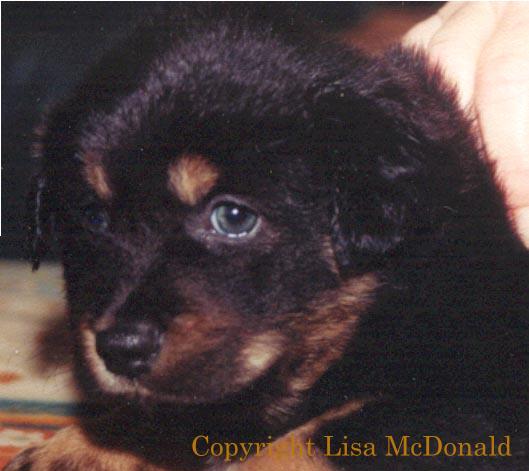
Our breed standard allows eyes of any pigment color or combination of pigment colors. Aussie eyes have been seen that are golden, lemon yellow, amber, light brown, dark brown, green, orange, and blue. On very dark individuals they may even appear black. The iris can be monochromatic, have concentric rings of color, flecks of darker pigment, flecks of blue, or be split or marbled with blue (heterochromia iridis). The two eyes of one dog are not always both the same color; one may be pigmented while the other eye is blue, or both may be pigmented but be of different colors (heterochromia irides). Blue eyes are not confined to merles; there is a recessive gene in the breed that produces blue or split blue eyes in solid colored dogs as well. There are probably multiple genes which together affect eye color and it is not possible to predict with certainty eye color from a planned breeding. As a generalization, brown eyes tend to be dominant to lighter eyes. There is some relationship between eye color and coat color as well, since black pups will tend to have slightly darker eyes than red pups in the same litter. Below are some examples of the extraordinary variety of eye color we find in this breed.

This black and tan Aussie pup is 6 weeks old. His eyes are beginning to change from the dark grayish blue of early puppyhood to his adult color of medium brown. From the beginning the grayish blue shade was fairly dark compared to the light shade of a dog who will have blue eyes. A puppy that will develop amber eyes will have eyes a bit lighter than these, but they will still be considerably darker than a puppy with blue eyes. Pups that are destined to have eyes that are very dark, almost black, will have dark irises of a midnight blue color from the beginning. In a puppy with split or marbled eyes part of the iris is dark like this pup's eyes, and the blue area is pale.
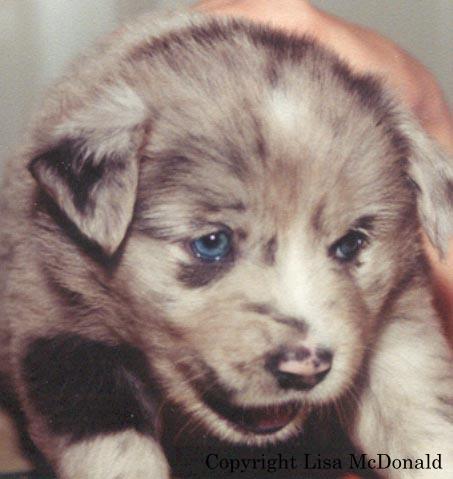
This female from the same litter has eyes that stayed blue. Note that they are much lighter in shade and bluer in hue than her brother's eyes. Puppies with marbled eyes will typically have indistinct flecks or smudges of blue like this puppy with the dark areas like those of the darker eyed puppy above. As eye pigment develops the colors will become more easily identifiable and crisp.
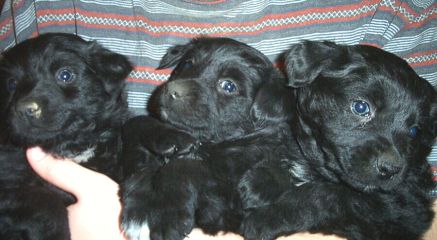
This photo of three lovely raven pups is courtesy of Sandy Cornwell. These 3 pups are nearly all black, and their adult eye color will be dark brown. At 5 weeks, their irises are a medium shade of gray and are darkening gradually. They are not the ice blue of the puppy above, whose eyes will remain blue. Pups with eyes destined to be fairly light, such as amber, would have irises a lighter shade of gray than these.
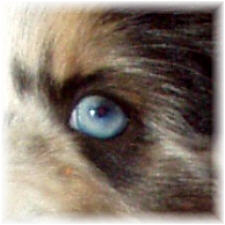
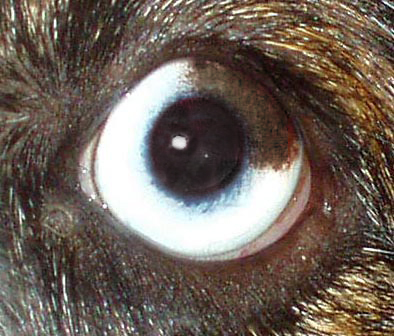
These are two photos of Frank (Shawtowns Frank James), courtesy of Jan Branham. On the left, Frank is 7 weeks old and his eye clearly shows a difference in pigment color. At this point the dark quarter is just an indistinct smudge of darker brownish gray on a greenish blue field. On the right Frank is an adult with a distinct quarter split.
When a dog's iris contains two or more colors, the medical term is heterochromia iridis. If the irises of his eyes are different from each other (one blue/one brown, etc) the term is heterochromia irides. Common terms for multicolored irises are split eyes and marbled eyes. Common terms for two eyes different from each other include odd eyed, walleyed, glass eyed. In domestic mammals having one pigmented eye and one blue eye is not uncommon. It's been observed in horses, donkeys, cattle, water buffalo, cats, ranched foxes, and dogs.

This blue merle Aussie belonging to Melanie Magamoll has a sky blue field with an indigo ring around her pupil. She also has deep blue flecks in the lower left of the indigo ring. It is not known at this time why some Aussies inherit the indigo ring while others' blue eyes are uniform blue. There are probably several genes involved.
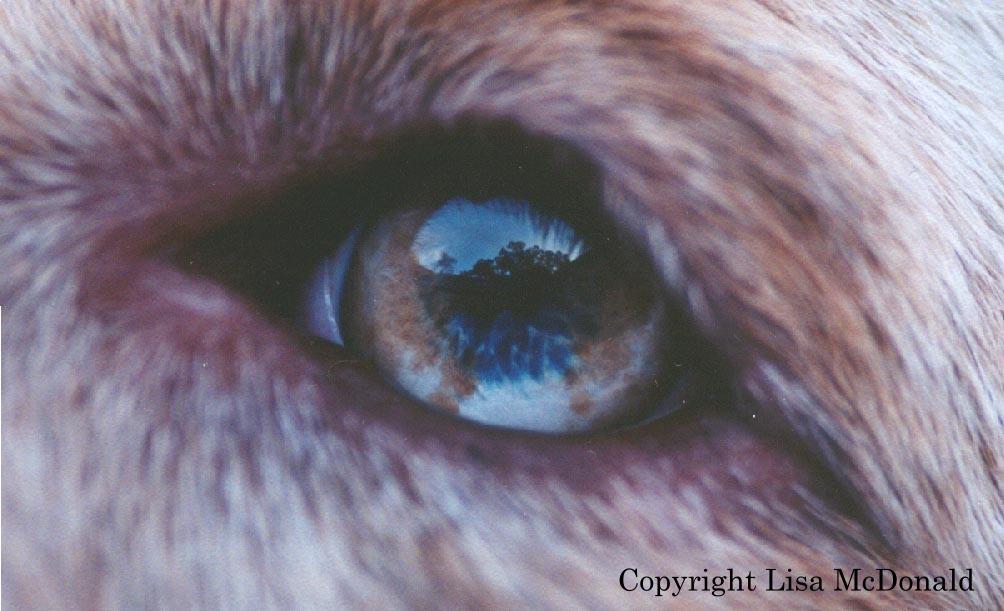
Jackson's eye shows dark amber with blue marbling. The light blue area has some fascinating heavy blue striations near the pupil. His right eye is amber with similar looking striations of darker amber. Jackson is a red merle.

Not all flecks are blue. Chaps has a blue spot in the brown half of his iris and a brown spot in the blue half! Chaps is a grandson of Krackers, a Slyrock dam.
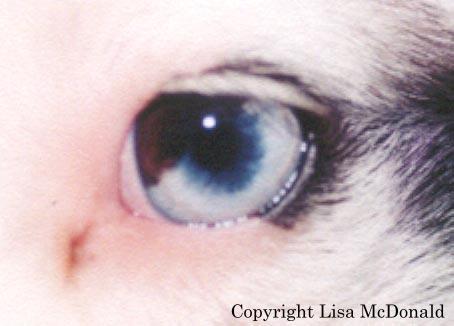
This is the eye of Scrappy, a blue merle. Scrappy has the sky blue field, the indigo ring, and some very dark brown marbling in the upper left corner of his eye. He has a partial mascara line on the right side of his lower eye. Pigment on the eyerim is highly desireable for preventing sunburn and skin cancer. The pink half is much more prone to sunburn than the black half.
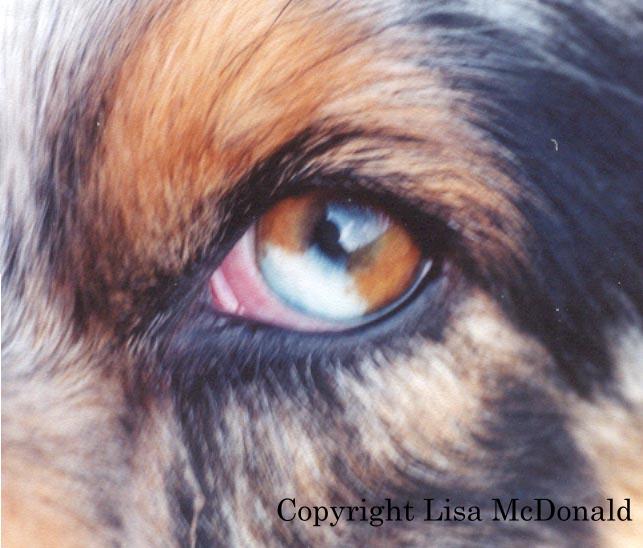
Hazel has blue marbling on her light brown eye. Sometimes a dog has two marbled eyes, and sometimes one is marbled while the other is not. This eye resembles a geometric split, but notice that the edges where blue meets brown are soft edged rather than sharp.
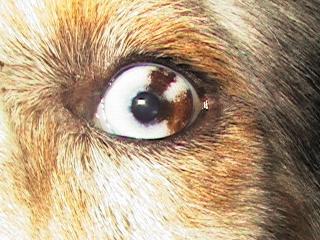
This rather striking eye belongs to Bonzer, a blue merle. His genetic eye color is dark brown, but the effect of the merling is to remove pigment from most of the iris. This gives him the very striking dark brown areas on a bright blue field. This is a very impressive marbled eye!

Zeke has some very interesting and attractive marbling. His base eye color is dark amber, but the iris is encircled by a darker brown ring. The eye is marbled in blue (left corner) and by a grayish color (bottom center). Here the distinction between blue and dark amber is a very soft blending without sharp distinctions.

Blue, pictured in the blue merle section, has dark amber eyes. In both eyes he has a darker amber ring around the iris and several brown flecks in the iris.
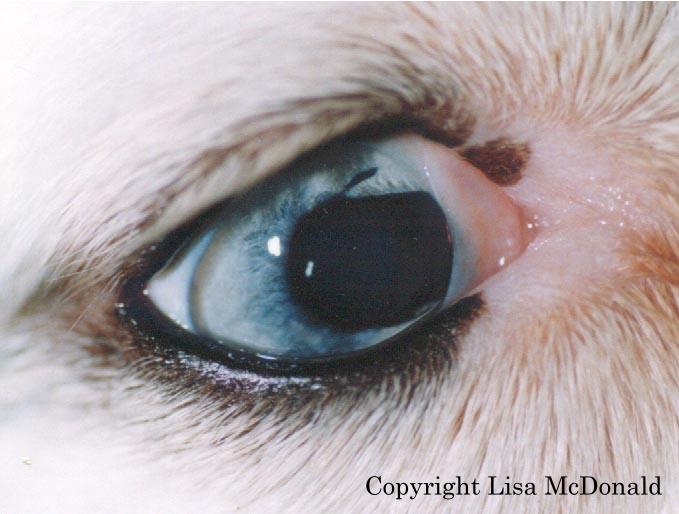
Vicky was a homozygous merle with blue eyes. Notice that a large piece of iris on the right side of the pupil is missing. This incomplete development of the iris is called iris hypoplasia. It is not uncommon in homozygous merles, though it can occur in other dogs also. Vicky had missing pieces of iris in both eyes. She also had a coloboma at about the 1 o'clock position in her iris. She tended to squint in bright light since her irises could not close down adequately to block out the excess light. She was able to navigate the furniture and toys in the yard without difficulty!

This is Fanfare, a lovely black bi with bright yellow eyes. Bold yellow irises like these are most often found on reds. They are definitely attention grabbing on a black dog. Research shows that livestock are quicker to retreat from the predatory threat of a dark colored dog with light eyes than to dogs with brown irises that don't stand out from the coat as much.
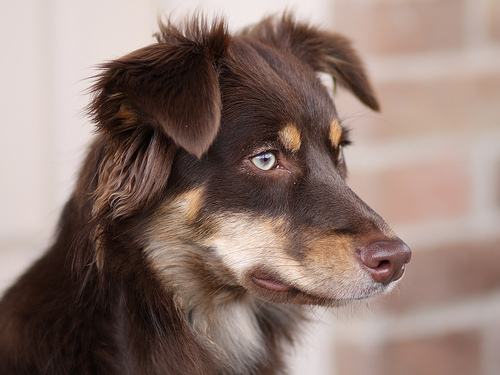
This is Mina, photo courtesy of Danette Brake. Her eyes have an arresting quality! They are just a shade darker than yellow and would be classified as light amber. Amber ranges in tone from very light eyes like Mina's through all shades of hazel.

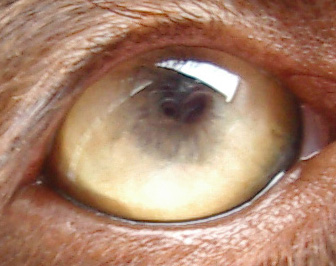
This is Willow, photo courtesy of Judy Rolff. She is a red tri with greenish amber eyes! Green eyes are most often seen in reds and red merles, much more rarely in blacks or blues. As an adult her eyes retained their arresting quality, though in the closeup of the iris they look more of a golden greenish.

This is Monanee, a sable merle Aussie, photo courtesy of Leona Stabler. His eyes are an intense wolf yellow. Although they are as light as a blue eye, he was never observed to squint in bright light. Most wild canids have eyes approximately this hue; it is a very durable serviceable color. Monanee is now a service dog for a young man in a wheelchair due to his large size and his desire to work.
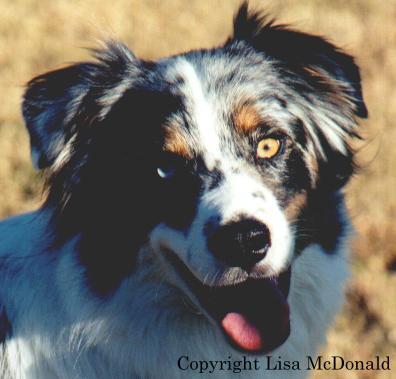
Tessa, owned by Mary Fillerup, is an example of a blue merle with a very light amber eye, almost yellow. Probably any red littermates of hers had even yellower irises. Her right eye is blue.

Breezy's irises are just a bit darker than Tessa's, and they are both bright amber. Breezy is a blue merle, and probably any red or red merle littermates of hers have irises even more toward the yellow range. I currently don't have any photos of a red or red merle with lemon yellow eyes, but I would be glad to add one if it is sent to me.
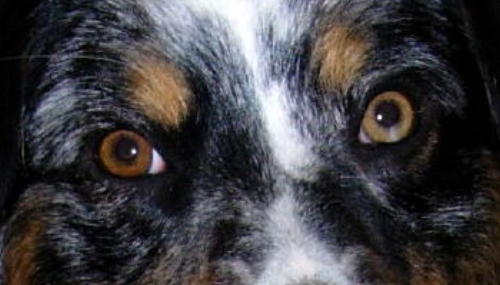
This striking blue merle guy is Tag (Touchstone Catch Me If U Can), photo courtesy of Jane McNee. He shows irises that are two separate and distinct shades of brown! His right eye (on our left) is medium dark brown, and his left eye is a caramel brown, approaching the lightness of amber. Presently it is not known if this is a heritable trait or just a phenomenon of fetal development.
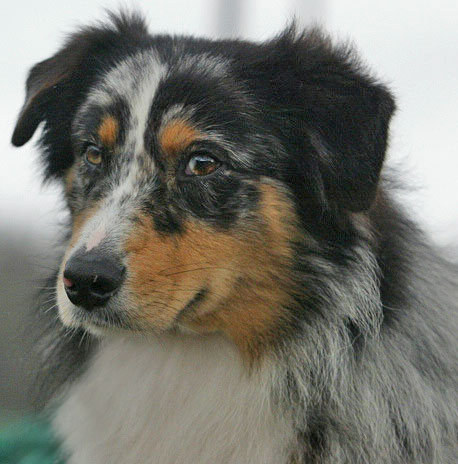
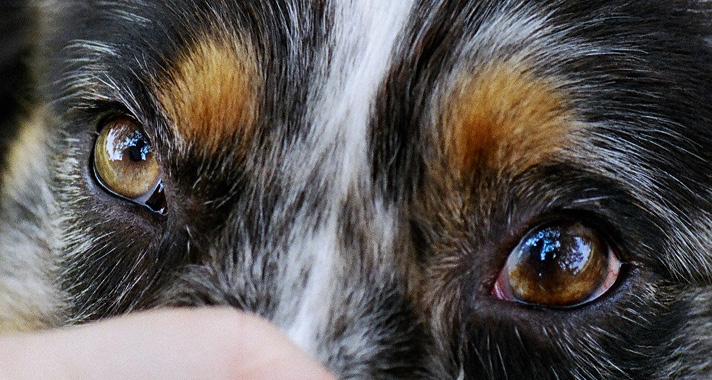
This handsome blue merle guy is Mystic (ASCA Ch. Callisto's Into The Mystic), photo courtesy of Gail Karamalegos. A closeup of his eyes is shown on the right, photo courtesy Lisa McDonald. His right eye is caramel brown, and his left eye is darker brown marbled with blue. Gail reports that he has no known relatives with this trait. She also says the difference in color did not become apparent until the irises started turning hazel from the normal puppy grayish blue. At that point there was clearly a difference that became most pronounced when the color change was complete from hazel to brown.
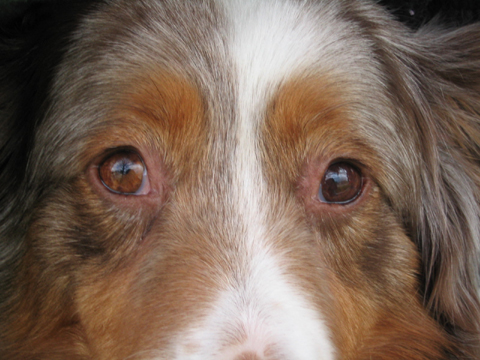
This lovely red merle girl is Marley, photograph courtesy of Wendy Cushnie of Canada. Marley is a red merle and she has two brown eyes of different shades. In her case one is medium brown and the other dark brown. Again, the exact cause of this difference in color is unknown, but it is a fully acceptable in the show ring as a normal variation.

And here we have a beautiful black tri named Delta (Shartooz Tale Ov Love), photo courtesy of Josie in Australia. We have a striking degree of contrast in color. The presence of this pigment pattern in a nonmerle suggests that some other factor is involved in producing it. Aussie eyes can be any color, and this is within the normal range of variation. It is a very unusual and fascinating variation that is very eye catching when it occurs.
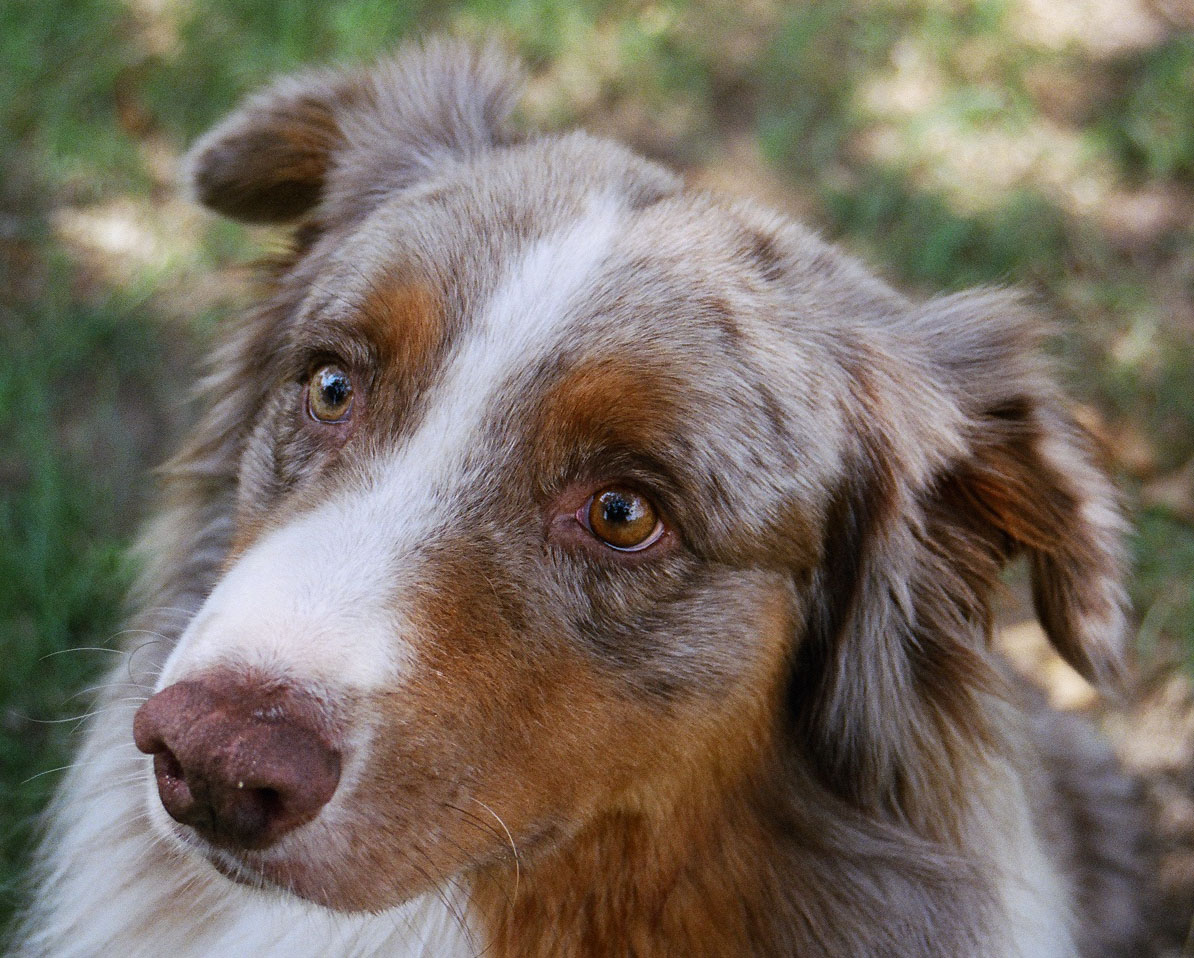
Is the tendency to have differently pigmented irises hereditary? Possibly. This is Matches, a red merle belonging to Kathi Linn. His right eye is amber with many flecks of brown pigment, and his left eye is brown. His son Maki also has two irises with different shades of brown. Unfortunately the colors of Maki's different eyes did not photograph well, even though it was very obvious when he was viewed in person. Of all the cases of nonblue heterochromia irides shown, this is the only case reported in which a parent produced offspring with the same type of eyes.
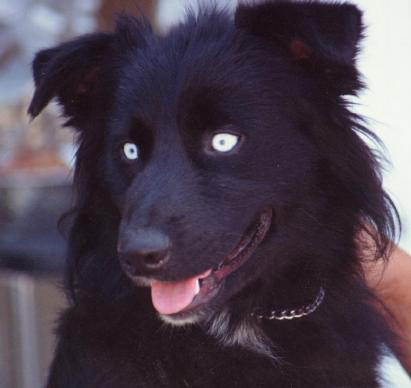
This gorgeous guy is CH Howard's Wanagi Ishna Ghost Eyes "Indy". He is almost entirely black with only a few white hairs on his toes and chin. He is a very minimal black bi. The presence of blue eyes does not always indicate a merle. This type of recessive blue eye can be observed both in merles and nonmerles. In Aussies, recessive blues like this are caused by a recessive gene similar to that found in Siberian huskies and Border collies. Recessive blues can be entirely blue like Indy's, or they can be geometrically split. This gene does not cause marbling. If a blue merle has solid blue or geometrically split blue, it's not really possible to tell by appearance alone whether the blue eyes are due to this recessive gene or due to the effects of merling.
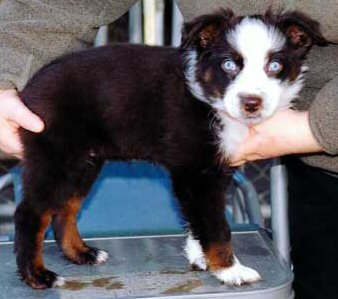
This is Mistretta's Chaca, a very dark red tri puppy with bright blue eyes that will remain blue. In some bloodlines, including this one, there is a recessive gene that causes blue eyes independently of coat color and not related to merling. These recessive blue eyes are most striking on nonmerles. One or both eyes may be blue. They may even be geometrically split, but they are generally not marbled.

This is Princess, owned by Mari Flippen, photo courtesy of Lyndy Jacob. Princess has two very striking eyes showing crisp hard edged geometric splits. In this case the split is diagonal. Interestingly enough, Princess has a full sister from another litter who also has a split eye. We don't know for sure if this is inherited, but it could be.
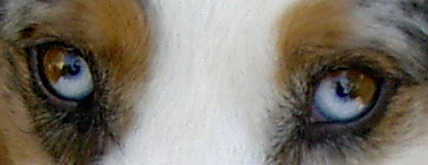
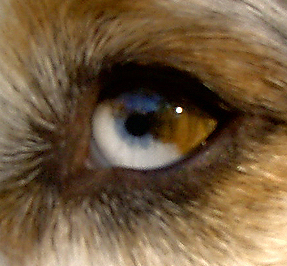
These are detail shots of Jasper's eyes, photos courtesy of Debbie Brown. His eyes show a similar split pattern to those of Princess, and here is what they look like close up. There's no intermixing of the colors at their borders, and you could just about lay a ruler down and draw the demarcation line.

This is Dix (Redwest's Dixie-Dog, CGC), owned by Brenda Hutton, photo courtesy of Camelback Photography. Dix shows both types of eye! Her right eye (our left) is marbled. Her left eye is a very crisp geometric split. As with Princess, her split is also on the diagnonal. She is an example of both types of eye patterns coexisting on the same dog.
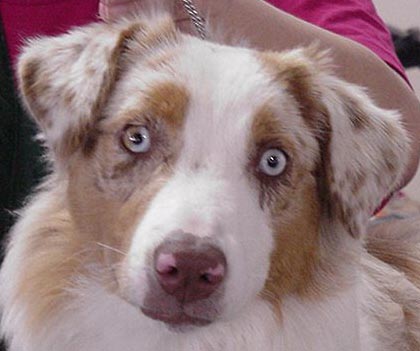
This is Boo (Moonlight's Witchy Woman), photo courtesy of Mark Raymond. Boo has a nearly vertical split in her right eye, very hard edged. Because her iris color is a medium amber the effect is more subtle than it is with the dogs above who have dark brown pigment in their irises.
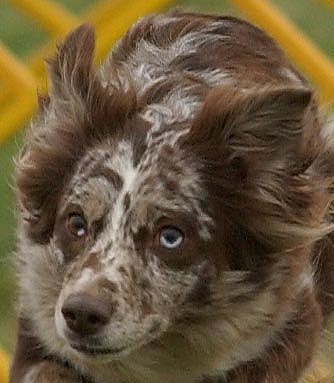
This is Belle, photo courtesy of Bekka Borg. In her very intense expression the geometric split is seen in her left eye (our right). She has a horizontal split in which the top of the eye is dark brown and the bottom is blue. When she is sleepy and her eyelids are partially shut she appears to have a blue eye on that side. The split can occur in any direction.
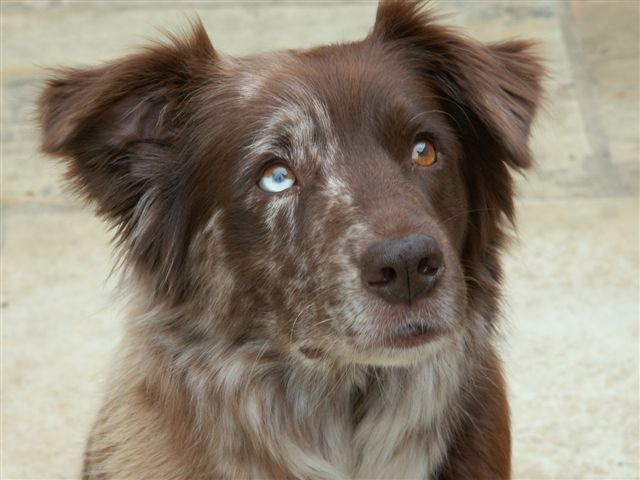
This is Remuda Bar Nitty Gritty For Topeka (Grit), photo courtesy of Linda Whyman of England and owned by Susan Beavers. This spectacular girl has both a split face AND a geometrically split eye! She also has a highly desireable very dark liver nose for excellent UV protection. Just a point of interest, her split eye happens to be on the same side as her merle half. It's not known at this time whether the same mechanism caused both types of split (face and iris).
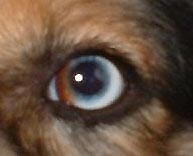
This is a detail shot of the eye of Austin (AKC/UKC/INT'L CH Keepsake Outta My Way), photo courtesy of Becky Tellalian. Not all geometric splits yield 2 equal halves. Austin's eye shows a nice sharp edged split, with the color division approximately 1/4 brown and 3/4 blue.
At the back of the eye there is a layer of reflective pigment called the choroid layer. This mirrorlike layer reflects available light and allows dogs to see well even in very dim light. In an eye with normal pigmentation the eye reflects a silvery greenish color in bright light. In eyes lacking pigment the eye reflection is red. Some dogs will have one of each. This layer is responsible for eyeshine in cats as well.
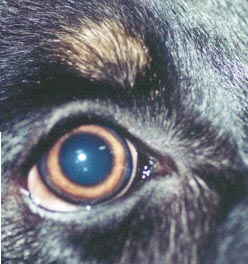
This is the eye of a black tri. The iris is dark amber and the choroid layer is well pigmented. This greenish reflection is the norm in most dog breeds and wild canids. This dog should see quite well in dimly lit conditions. No dog can see in total darkness, but they can easily navigate in condtions that would have us tripping over dirt clumps.
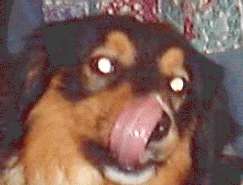
This is another black tri whose eyes have been caught in the flash. The angle is more head-on than in the previous picture, so the silvery aspect predominates here.
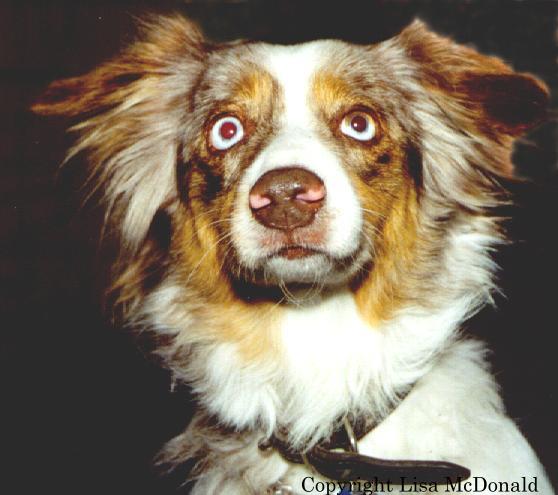
This red merle girl has blue eyes due to the action of the merle gene, and the choroid layer has been depigmented. Without pigment to cover the choroid layer, the bed of capillaries underneath reflects red in bright light. A similar effect is seen in humans and horses with light colored irises. In practice, most blue eyed dogs with depigmented choroid layers see better in the dark than we do. But they probably do not see as well under the dimmest conditions as dogs with normal choroid pigmentation.

This is CH Watermark's Harris o' Fairoaks "Tweed", photo courtesy of Kim Monti. Tweed has a partial split face and both of his irises show reduction in iris pigment due to merling. The blue eye reflects red in the camera flash because the choroid is depigmented like the iris due to merling. The mostly brown eye also shows red eyeshine; the iris and the choroid layer do not always show the same degree of merle depigmentation. In Tweed's case the choroid layer of his brown eye is more depigmented than his iris.
© 1999-2009 Lisa McDonald Comments